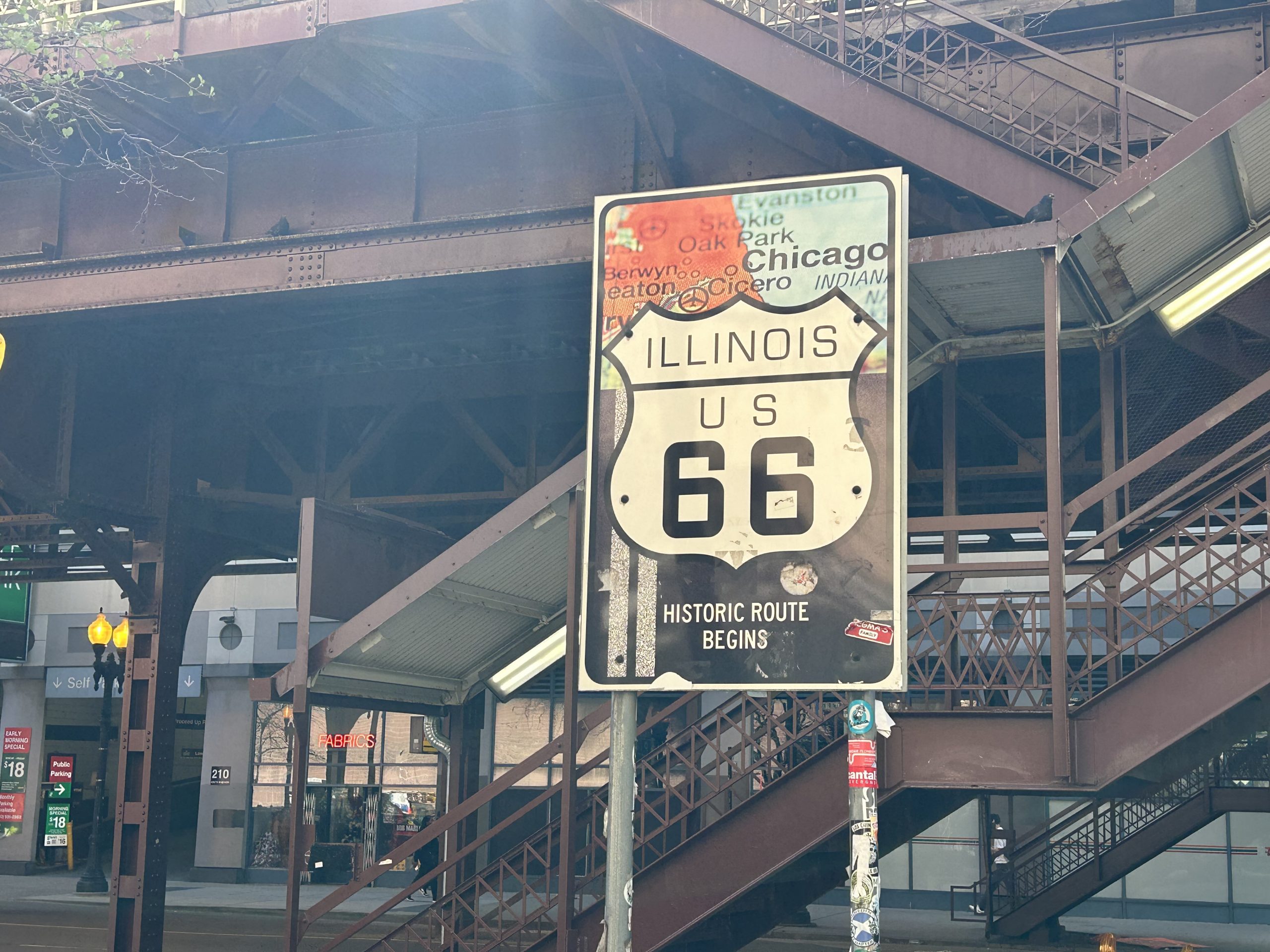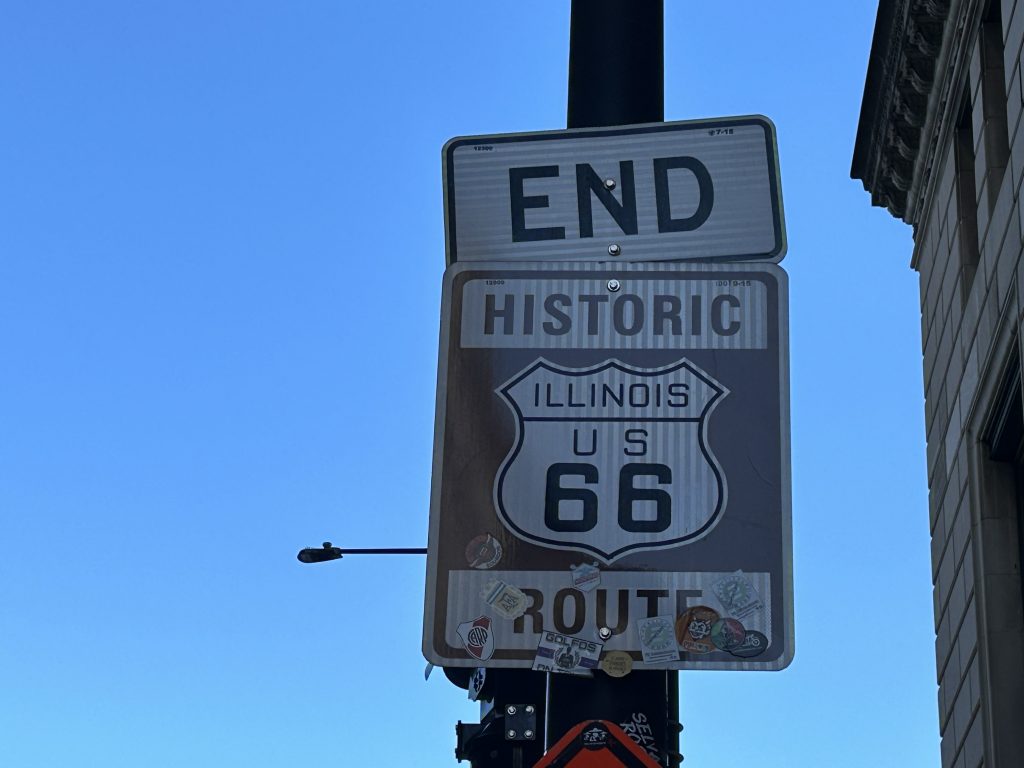
How Route 66 Became America’s “Mother Road”
Published on April 18, 2024
eATLAS has two tour Adventures dedicated to Route 66. The first explores 12 landmarks that can be found near its terminus point in Chicago’s Loop, and the second is a 300-mile excursion that spans the entirety of the road in Illinois, from Chicago to the Chain of Rocks Bridge in Granite City, with stops at 16 restaurants, tourist attractions, and historical sites. Route 66 is also included on our CHIstory ScavHunt Adventure, which takes place May 31st-June 2nd, with a chance to win cash prizes totaling $5,000.
By Dave Lifton (@daveeatschicago)
The growth of the automobile industry in the 1910s prompted the need to replace the network of wagon trails and dirt roads traversing much of the U.S., and the Federal Aid Highway Act of 1921 was passed to facilitate its creation. A pair of wealthy businessmen, Cyrus Avery of Tulsa and John Woodruff of Springfield, Mo., had long-lobbied the government for a road to connect Chicago and Los Angeles that, naturally, ran through their respective cities, and it eventually paid off. A route was pieced together from mostly existing roads, and U.S. Highway 66 was officially designated on April 30th, 1926 in Springfield, Mo.
Running from the corner of Jackson Blvd. and Michigan Ave. in Chicago to the intersection of Olympic Blvd. and Lincoln Blvd. in Santa Monica, Calif., Route 66 spanned 2,400 miles through six other states. Unlike previous attempts at transcontinental highways, Route 66 circumvented the mountains and, for the bulk of the route, went through warm-weather climates, making it more amenable to truckers transporting grains and produce cross-country.
But in its first 12 years, large stretches of the highway—particularly in the most rural stretches in the newly admitted states of Oklahoma, New Mexico, and Arizona—were not paved. During the Depression, New Deal programs allocated funds to not only pave Route 66, but also widen it and remove many of the curves.
By the time it was completed in 1938, Route 66 had played a part in the largest mass migration in American history. During the Dust Bowl, 2.5 million people left their homes in the Great Plains states, with 200,000 relocating to California. In his 1939 novel The Grapes of Wrath, John Steinbeck described the journey the Joad family and many others took, calling Route 66 the “mother road, the road of flight.”
Route 66 also served a vital role in national defense. In the 1930s, numerous military bases were built on or near the highway. The proximity of the installations to the road allowed trucks to quickly transport troops and supplies during World War II. Factories sprung up across California to fuel the war effort, and more than 1 million people moved out west to work in them.
In 1946, songwriter Bobby Troup and his wife were moving to Los Angeles via Route 66 when inspiration struck. As he recalled in 1985, she came up with the phrase “Get your kicks on Route 66,” and Troup went to work on an urbane blues song about the joys of traveling out to the West Coast via the road. He pitched the half-finished tune to Nat King Cole, who asked Troup to complete it. Cole’s recording of “(Get Your Kicks on) Route 66” has become one of his most enduring hits, and has been covered by such artists as Bing Crosby with the Andrews Sisters, Chuck Berry, the Rolling Stones, Depeche Mode, Manhattan Transfer, Glenn Frey, Asleep at the Wheel, and John Mayer.
The song coincided with the post-war economic boom, which resulted in more Americans having cars and jobs that afforded them more leisure time. To meet the demands of those using Route 66, the road became dotted with motels, gas stations, general stores, diners, and roadside attractions. The look of these mom-and-pop business—sleek with eye-catching neon—bridged the Art Deco and Mid-Century Modern movements, often adding Southwest flair. They became the iconography of Route 66, and defined Americana in the Space Age. And they boosted local economies.
From 1960-64, Route 66 aired on CBS. The drama starred Martin Milner and George Maharis as a pair of young men traveling the road in a Corvette convertible, encountering the locals and their issues. But Route 66’s fate was already sealed. In 1956, President Eisenhower signed the National Interstate and Defense Highways Act, which created the interstate highway system. Three high-speed, controlled-access roads—I-55, I-44, and I-40—were built near Route 66 from Chicago to Barstow, Calif., and segments of I-15 (Barstow to Ontario) and I-10 (Ontario to Santa Monica) made up the rest. By 1985, the final pieces of what was left of Route 66 were decommissioned, and many of the businesses along the highway were devastated.
However, those who understood the historical and cultural significance of Route 66 took action. Preservationists at the local, state, and federal levels have worked to protect not just the 85 percent of the original road that still exists, but also those businesses that made Route 66 so important to America.


The Adventure starts when you say it does.
All eATLAS Adventures are designed and built by experienced eATLAS Whoa!Guides. They're always on. Always entertaining. And always ready to go.
Check out our Adventures!